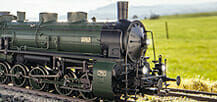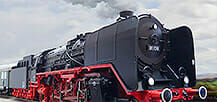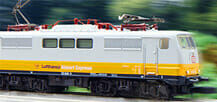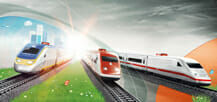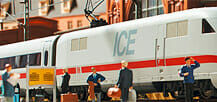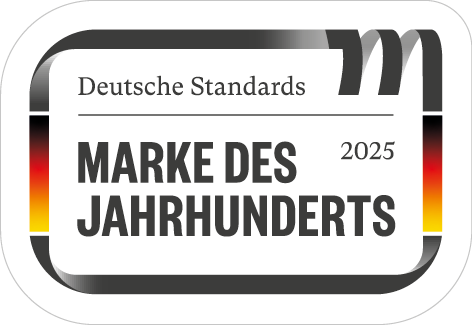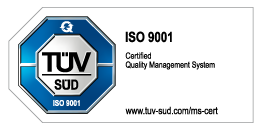Electric Locomotive.
Prototype: German Federal Railroad (DB) class E 03 express locomotive. Pre-production version in the crimson red / beige TEE paint scheme with double-arm pantographs and a single row of side vents.
Most Important Facts
| Article No. | 55104 |
|---|---|
| Gauge / Design type | 1 / |
| Era | III |
| Kind | Electric Locomotives |
Check with your local dealer Find Dealer
Highlights
- Prototypical pre-production version of the E 03.
- Double-arm pantographs that can be raised and lowered with motors in digital operation.
- mfx decoder for operation with AC power, DC power, Märklin Digital, and DCC.
- Powerful all-wheel propulsion by means of a centrally mounted motor and cardan shafts.
- White LEDs for the headlights and interior lights.
-
Product description
Model: The locomotive's frame and the side frames on the trucks are constructed of metal. The body is prototypically divided into parts and is constructed chiefly of metal. The locomotive has an mfx digital decoder, controlled high-efficiency propulsion, and extensive sound functions. The locomotive can be operated with AC power, DC power, Märklin Digital, and DCC. The locomotive has a powerful motor, centrally mounted. All of the axles in both trucks are powered through cardan shafts. The white headlights and red marker lights are LED's; they will work in conventional operation and can be controlled digitally. The locomotive has white LED's to light up the engineer's cab at the front of the locomotive (depending on the direction of travel) and the engine room. The engineer's cab doors can be opened, the locomotive has interior details, and there is a figure of an engineer in cab 1. The grab irons are metal and there are many other separately applied details: DB signs, windshield wipers, antenna, whistle, headlight bezels, and much more. The double-arm pantographs can be raised and lowered with motors in digital operation. The buffer beams have sprung buffers and separately applied brake lines. The Märklin couplers can be replaced by closed end skirting and prototype couplers.
Minimum radius for operation 1,020 mm / 40-3/16".
Length over the buffers 60.9 cm / 24".The contemporary car types for the TEE "Rheingold" in the sets, item nos. 58048 and 58049, are the right express train passenger cars to go with the E 03.
Find more Märklin explanation videos on our YouTube Channel
Spare parts for our articles can be found here in our spare parts search.
-
Publications
- New items brochure 2010 - Product programme 2010/2011 - Product programme 2011/2012
-
Prototype information
The Class 103 - the DB's Media Star! The German Federal Railroad ushered in a new era, when the class E 03 was presented in 1965 at the International Transportation Exhibition in Munich: regularly scheduled passenger service at 200 km/h / 125 mph. In addition, the class E 03, designated as the class 103 in the German Federal Railroad's roster from 1968 on, represented a milestone in locomotive development - it was the first express locomotive to surpass the class E 19, whose design dated back to the Thirties. Reason enough to be proud of this powerful, beautifully shaped locomotive and to put it accordingly in the limelight. Hardly any other locomotive like the class 103, known for an entire generation as the Intercity locomotive, was marketed so much in the media. In TV ad spots, posters, and brochures this locomotive became a symbol for the German Federal Railroad's dynamism, a guarantee for reliability, speed, and comfort. Extensive test runs, among them regular speeds of 200 km/h / 125 mph between Munich and Augsburg, were done with four prototypes, until the class 103 was purchased as a regular production unit starting in 1970. The 145 locomotives differed from the prototypes in leaving off the decorative striping and in double rows of vents. Single-arm pantographs were installed on the locomotives from 1976 on, and the last series of units delivered had longer engineer's cabs, because crews complained about the cramped work space. The aerodynamic, six-axle locomotive had a total continuous power rating of 7,440 kilowatts / 9,977 horsepower and was the most powerful DB locomotive until the use of three-phase current technology. The high startup tractive effort as well as the electric brakes, independent for the first time of the catenary and connected in series with air brakes, drew favorable comment worldwide. The performance strengths of the 103 were reflected in the enormous number of runs and even today it is still rated as the locomotive with the highest level of service life in Germany. Its uncommonly attractive looks remained essentially unchanged during its use on the DB. In later years, the skirting and the buffer cladding were removed and several locomotives were painted in the "Chinese red" color scheme; only one unit was painted in "traffic red". The German Federal Railroad's class 103 was very popular with crews and passengers right up to the end of its regularly scheduled use, and it is understandable that a considerable number of them have remained preserved as museum locomotives. Many people today remember back as if it were just yesterday when they were young and how the 103 flew past them on the station platform.
-
Digital Functions
Control Unit Mobile Station Mobile Station 2 Central Station 1/2 Central Station 3/2*
Mobile Station 2**Headlight(s) Engineer’s cab lighting Electric locomotive op. sounds Locomotive whistle Direct control Station Announcements Pantograph 1 Conductor's Whistle Pantograph 2 Sound of squealing brakes off Headlight(s): Cab1 End Headlight(s): Cab2 End Compressor Letting off Air * New features of the Central Station 2 (Part No. 60213, 60214 or 60215) with the software update 4.2
** New features of the Mobile Station 2 (Part No. 60657/66955) with the Software Update 3.55
